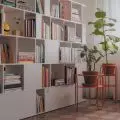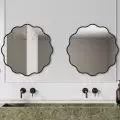On the campus of Bialystok University of Technology, part of the informal green space has been transformed into a biocenotic garden with a relaxation area. The whole area, named Cyclarium Sloboda, is part of the "Laboratory of Happiness Research" project and aims to create a space conducive to the coexistence of fauna, flora and humans.
Sloboda Cyclarium
Photo: Dariusz Piekut/Bialystok University of Technology
The cyclical nature and sensory experience of space
The design of this space was inspired by the idea of cyclicity - both in the lives of people and trees, and in the changes of seasons or phases of the moon. This is why the facilities were named "Cyclarium Sloboda." The Bialystok University of Technology campus was built on the site of the former village of Sloboda, which existed since the late 17th century and was annexed to Bialystok in 1919. Remnants of the village, including a group of old apple trees, played a special role in the project, which found its place in the cyclone.
A key conceptual element is experiencing nature with all the senses, or sensorium , including the smell and texture of plants, the sounds of rain, wind and birdsong. In addition, the design incorporates the aspect of circularity, for example, by creating a natural compost pile, based on soil and fallen leaves.
We came up with the idea of cooperation with the circle of foresters, the circle of environmental management, and the circle of Rolka, because we are all concerned with shaping the environment in general," says Dr. Marta Baum, from the Department of Sustainable Construction and Building Installations of the Faculty of Building and Environmental Sciences at Bialystok University of Technology - supervisor of the student research circle Green Space, operating in the landscape architecture faculty. - We came to the conclusion that, as part of the My Green PB strategy, we can get an area from the University of Technology where we will conduct our research, at the same time we will create such a space that will be very biodiverse, very natural, and where we will be able to experience nature in such a way that is already hardly possible. We established cooperation with the Arsenal Gallery and it turned out that our idea fits in with what the Arsenal Gallery does, and hence the creation of the Słoboda Cyclarium.
Słoboda Cyclarium
Photo: Dariusz Piekut/Bialystok University of Technology
The scheme for the development of the site was developed by students of landscape architecture at the Faculty of Construction and Environmental Sciences of Bialystok University of Technology: Dominika Bielawska, Patrycja Dzieniszewska, Natalia Rzepniewska, Karolina Sadowska, Izabela Kozak, Agnieszka Mackiewicz, Agata Szymanowska and Natalia Miłosz, in cooperation with the Scientific Circle ROLKA, the Scientific Circle of Foresters of INL PB, the Scientific Circle of Environmental Management and the Scientific Circle of Landscape Architecture "Green Space". All these groups are active at the Faculty of Construction and Environmental Sciences of Bialystok University of Technology. Earlier, Arsenal Gallery invited the Forma Student Scientific Circle from the Faculty of Architecture at Bialystok University of Technology.
space inspired by history and nature
Supervisor of the Forma Scientific Circle - Aleksandra Jakuć - emphasizes that the creators and creators of the project wanted to create a space to which they themselves would gladly return and invite their friends. It was decided that all the names would refer to the former village of Sloboda. Thus, "Jars" appeared, symbolizing the characteristic circles of trees, which were to be visible and at the same time serve as a place to rest and tangibly experience their structure.
Cyclarium Sloboda - Stoje
Photo: Dariusz Piekut/Bialystok University of Technology
Another element is the "Strawmen " - rest sets made of wood, straw and hay, characterized by exceptional thermal insulation properties. As Jakuć recalls, "spending cooler evenings in the Słoboda Cyclery, it turned out that straw actually warms," which confirmed the project's assumptions. The inspiration came from thatched roofs and traditional methods of using natural materials.
Słoboda Cyclery - Słomaki
Photo: Dariusz Piekut/Bialystok University of Technology
Also created was a sound installation called "Wordsmiths," with elements moving in the wind, such as branches and ceramic forms. It was a way to engage different senses. As Jakuć points out, the space was primarily meant to be used for relaxation, but it was equally important to find ways to stimulate other senses, hence the installation reacting to a natural gust of wind.
Cyclarium Sloboda - Słowieje
Photo: Dariusz Piekut/Bialystok University of Technology
The project also includes "Sloplots " - organic hammocks, whose form and size were defined by the natural placement of trees, which is the creators' response to the existing space. Composters called "Slobodas" are another element of the project, referring to fertilizers, implemented by students of the State High School of Fine Arts in Suprasl.
Słoboda - Słopłoty cyclery
Photo: Dariusz Piekut/Bialystok Technical University
jars
Old tree trunks were placed under the apple trees, which grew at the time when the village of Sloboda was located on the grounds of the Cyclarium, in such a way that one can sit together with friends, relax and reunite with nature. Bartosz Skarzynski, a student of interior design at the Faculty of Architecture at Bialystok University of Technology, explains that the apple trees symbolize the sacredness of the place, so the trunks were set in a circle, which promotes unity with both nature and each other.
Sloboda Cyclery - Stoje
Photo: Dariusz Piekut/Bialystok University of Technology
strawmen
The hay and straw c ouchinstallation is a kind of design joke in the form of a couch, created from natural materials. Lukasz Gudajtis, a student at the Faculty of Architecture at the Bialystok University of Technology, notes that "Strawmen" evoke the old days when their grandparents slept on various mattresses. The couches have excellent thermal insulation properties, giving off heat, which has been tested many times during the cooler summer nights. Moreover, they fit in with the idea of the cycle, as they are a seasonal installation that will decay over time and become home to various insects and fungi.
Cyclarium Sloboda - Slomaki
Photo: Dariusz Piekut/Bialystok University of Technology
słowieje
The Słowieje sound installation is an art installation that is a combination of knotweed, bamboo and ceramics, which works on people's sensory perception, on the sense of hearing, but also of sight and touch, in order to just observe the music that nature plays for us, but also with the use of our various traditions transported from folklore, explains Wiktoria Kulgawczuk, a graduate of the Faculty of Architecture at Bialystok University of Technology.
Cyclarium Sloboda - Slovyje
Photo: Dariusz Piekut/Bialystok University of Technology
słoploty
The design of the Słoboda Cyclarium includes a so-called "respite space," an area designed for relaxation. Aleksandra Jakuć stresses that it was crucial that the design interference was minimal, in order to respond to the found natural conditions in the least intrusive way possible. The project, with the participation of the Form Circle, included hammocks with organic forms, the shape of which was defined by the distance between trees, and benches made exclusively from natural materials such as trunks, branches and ropes.
Sloplots, or hammocks made of jute rope, are a kind of human invitation to the relationship between fungi and trees, because fungi and trees live in symbiosis, says Lukasz Gudajtis, a student at the Faculty of Architecture at Bialystok University of Technology from the Forma student research club. - The fungi surround the roots of the trees, taking nutrients from them and protecting them from pests, and in return they take other nutrients that they cannot get directly from the soil. These hammocks are a kind of invitation to an interspecies relationship. Symbolically, this mycelium, which is underground, is stretched above the surface of the ground, and this is how the Słoplots were created.
Cyclarium Sloboda - Sloplots
Photo by Dariusz Piekut/Bialystok University of Technology
wordzy
Barbara Budnicka, a student from the State High School of Fine Arts in Suprasl, created a composter with other students. They wondered what could be useful in urban space and what would help unite people with nature. Reaching into the past and thinking about the possibilities, they came to the conclusion that a composter would be the best solution. They began by designing a form that would provide airflow, be waterproof and at the same time have artistic and visual qualities. They created more than a dozen designs, and the final composter was realized with the substantive support of Mr. Stefan Wyszkowski. It took a rather simple, slightly rustic form, referring to the wooden architecture of Podlasie, and at the same time fulfilled its utilitarian functions.
Biocenotic garden
Photo by Pawel Jankowski/Bialystok University of Technology
research zones
All the student scientific circles that worked on the campus were also tasked with designating zones for scientific research. Dr. Marta Baum of the Department of Sustainable Construction and Building Installations of the Faculty of Building and Environmental Sciences at Bialystok University of Technology, who is the supervisor of the student scientific circle "Green Space," stresses that in planning the biocenotic garden, the landscape architecture circle, after consulting with other circles in the faculty that deal with environmental design, designated zones for preliminary research, including a zone for a soilbarium, flower meadows and a zone for water bodies.
Biocenotic garden
Photo: Pawel Jankowski/Bialystok University of Technology
The male and female students walked the site, checked where there were natural depressions that could collect water, and designated specific spaces. Some of them, such as a flower meadow, are already in place, while a glebarium and water tanks will be created in the coming weeks. Students from the landscape architecture circle, after consultation, designated spaces for leisure activities, including places for hammocks, seating and sound elements, and the Forma circle was responsible for implementing the projects.









































































